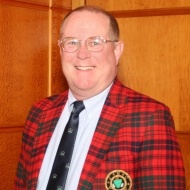Since 1991, Bruce Matthews, of Lansing, Michigan, has designed over forty-five new courses and renovated over sixty, and is known for his ability to design upscale courses at affordable prices. He was a superintendent at high-end private clubs and ran a public course. His father managed Grand Haven Golf Club for thirty-seven years, where Bruce learned the golf business from the bottom up: cleaning clubs, picking the range, and filling pop machines before being promoted to the grounds crew.  Bruce is a third-generation member of the American Society of Golf Course Architects. Matthews’s grandfather designed and built golf courses and his uncle Jerry is also an accomplished architect. Some of Bruce’s Michigan courses include Angels Crossing in Vicksburg, Hidden River Golf and Casting Club in Brutus, and Beeches Golf Club in South Haven. He also remodeled Grosse Ile Country Club and the Country Club of Lansing.
Bruce is a third-generation member of the American Society of Golf Course Architects. Matthews’s grandfather designed and built golf courses and his uncle Jerry is also an accomplished architect. Some of Bruce’s Michigan courses include Angels Crossing in Vicksburg, Hidden River Golf and Casting Club in Brutus, and Beeches Golf Club in South Haven. He also remodeled Grosse Ile Country Club and the Country Club of Lansing.
A golf course is an undefined field of play and is open to personal interpretation. Not all people have the same tastes. I am as passionate and serious as other golf course architects. I pull on my education, experiences, and skills to put my personal thumbprint on the earth’s surface. To me, being a golf course architect is about making people happy.
Last year at a local golf show I was standing by a booth of a course I designed. A gentleman reading the materials said, “Hey – this course was designed by Bruce Matthews. I know all about his courses.” Naturally, I asked him what he knew about the courses. “He designs long par 3’s on each of his courses,” he replied, and on he went. He was genuinely happy and excited about golf.
I really enjoy sitting on the porch or in the bar of a course that I have designed. In the crowded room I’m that quiet guy sitting at the table. I can hear a lot from the table. There are happy people, talking about how they mastered a golf hole. Others are explaining that the match will be different next time. The big guy is telling his foursome how the eighth hole could have been better with another bunker. His buddy saying that the ninth hole is the best par-4 he has ever played. The instant feedback can be quite euphoric.
I spend countless hours are spent compiling and recording base information and mapping the site’s opportunities and constraints. I spend hours listening, questioning, and listening again, making sure the parameters of design are understood and incorporated. The strategic routing flows through the open areas and woodlots avoiding the wetlands. One owner’s sacred, half-buried, rusty Ford Pinto still sits by the fence post in the trees behind the new eighteenth tee. The owner walks back behind the trees, looks, and comes back to the tee, smiling with another Ford Pinto story.
It’s about the process, properly lining up all components of the design and interlocking where necessary. There is the constant push, pull compromise with government agencies, engineers, consultants, and contractors. Consider the case of the oak tree in the middle of the fairway. Everyone tells me the tree should not be there. They say the tree obscures the view of a very scenic golf hole. It knocks down the good tee shots that otherwise would be in the middle of the fairway. I have pled my case of where, why, and how it should happen. For the good of the game, it must go…except I played the hole recently and worked my tee shot around the oak tree into the fairway beyond. As I picked up my tee I looked up at the owner and grinned. “See, I guess it’s not that hard.”
Much of what I do is convey the technical elements of golf course architecture into layman’s language. It never ceases to amaze me that as we walk through the site during construction the client says, “How did you find that hill for that green site?” or “I never knew I owned that property.”
